Overview.
Kentucky is emerging from the current major holidays of November and December in what is the third major surge of Covid-19 since our first case 653 days ago on March 6, 2020. We responded to an opening mini-wave that stabilized in early May 2020 with a moving 7-Day average of around 205 daily reported cases. We were plenty worried at that time and pulled out all the traditional non-pharmaceutical remedies we had available. That seemed to work even though there was much resistance to the disruption of our social order.
Things got a little better for a while, but the rolling average never dropped below 126. The Fourth of July holiday and entry to the summer season began a gradual but progressive rise in cases that never really ended. Cases (and deaths) exploded beginning in early October 2020 from an average of 760 per day, to twin peaks of 3412 and on December 5, 2020 and January 12, 2021 respectively. This initial major epidemic surge was caused by the original Alpha variants. Vaccines became available to high-risk individuals and by mid-January 2021 to adults older than 65. For this and other reasons, daily case numbers began to slowly decrease to a daily average of 146 by the end of June 2021. We thought we had won and many, including myself, moved back closer to a more “normal” lifestyle. However, Covid-19 had not disappeared elsewhere in the world and if it is anywhere, it is a risk everywhere!
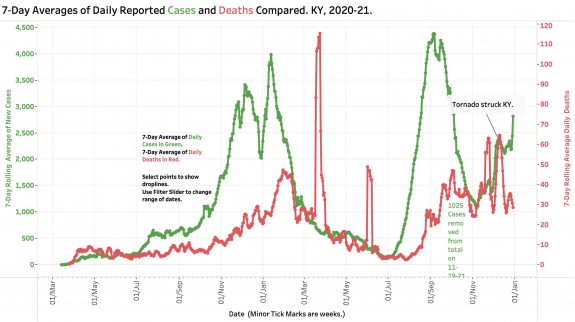
Curves for Cases and Positivity Rates are in the “going straight-up” mode.
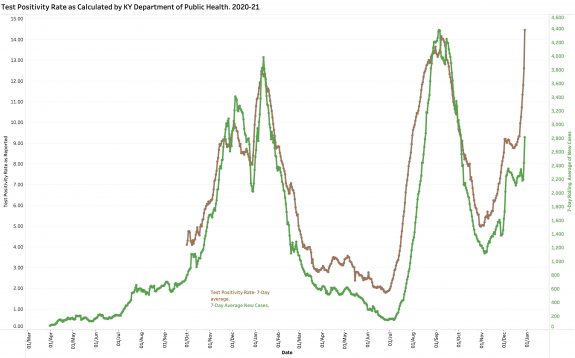
Beginning again around a second Fourth of July 2021 and for the rest of that summer, the arrival of the Delta variant spiked a second major surge of Covid-19 with a new record high on September 5th of 4383 average cases per day. We were once again scared and promoted primary vaccinations and boosters hard. Many but not all began to live more cautious lifestyles again. The delta peak passed but never really had a chance to fall to previous baseline counts. The lowest we reached was 1131 average daily cases in early November. Since then, as chronicled in these articles, there has been a relentless increase in both the test positivity rate and the case count that follows closely viral prevalence in the community. There was little or no “plateau” of cases. By mid-December, both metrics literally exploded with the most recent available single-day numbers on December 29th of 14.5% and 5513 cases respectively. These are the highest daily values since Kentucky’s epidemic began. Investigations are ongoing, but this third major surge probably initially involved residual Delta variant but is being hijacked and fueled by the new and extraordinarily contagious Omicron variant as is happening worldwide. An increase in hospitalizations accompanied these rises. What happens with respect to deaths and long-term disease morbidities remains to be seen. There is no indication yet that cases have peaked. I do not believe they have.
How severe are the cases?
The definition of having a “severe” complication of Covid-19 usually includes requiring ICU or ventilator care. Along with an increase in overall hospital admissions for Covid-19, ICU availability is becoming saturated throughout the state. As of the most recent tally on Wednesday, December 29th of the state’s 10 regional Hospital groupings, 8 had >90% “ICU Capacity in Use” and 6 with >95%. Compare this to the first Wednesday of November when these figures showed only 4 regions with >90% and 1 with >95%. (Recall that an effective ICU capacity implies that the beds have the staff to care for the patients. Medical staffing is a big problem nationally and I am not currently aware of how Kentucky defines “Capacity in Use.”)
[Addendum 1-3-22: Marissa Plescia and Molly Gambele ranked states with hospital workforce shortages in today’s Becker’s Hospital Review. Of the 16 states with at least 25% of their hospitals currently experiencing critical shortage as of 12-28-21, Kentucky ranked 9th with 32% of its hospitals. There were another 21 states that expected to be in the shortage category within a week. Seems to me that we are in trouble!]
Below is what the raw daily case counts look like since July 2021.
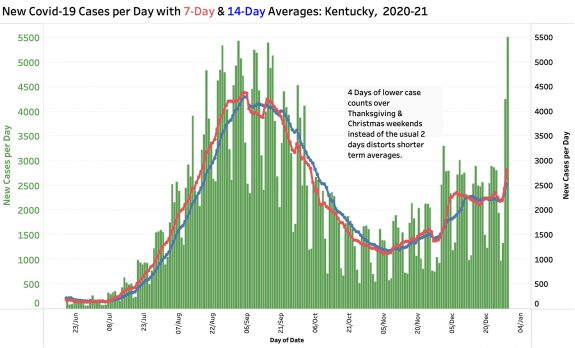
Nothing benign about the hospital utilization curves below.
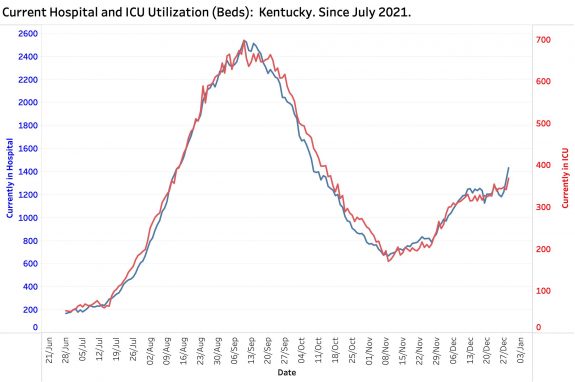
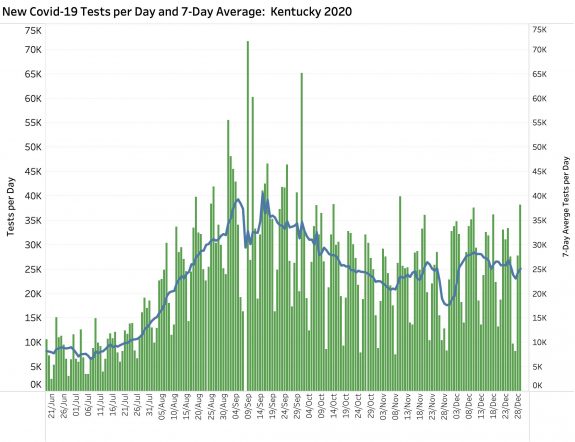
Flying blind for a while.
How bad is it really and how bad will it get? It is hard to tell. We are in something of a data desert now. Cases have been rising faster than we are able to count or report them. Looking at other states and the rest of the world, we still have a way to go in the wrong direction. The most recent Kentucky numbers reported in the state (and to the CDC?) were on Thursday, December 29. Kentucky and several other states stopped reporting on weekends. The numbers for last Thursday through next Monday might be available as early as Monday evening, but it will surely take longer to fully catch up with what is happening in the real world. Elsewhere, the Omicron variant has been associated with a doubling rate of Covid-19 cases that is measured in a few days, not weeks. In addition to the usual data collection and reporting anomalies related to the workweek, several major fall and winter holidays exaggerated reporting delays at the same time greater interpersonal epidemic spread is assumed. To make matters even more uncertain, the recent tornado disasters in western Kentucky have placed extraordinary demands on our existing public health services. Disasters like that one create breeding grounds for spread of disease that will reliably make Covid-19 matters worse. I would do a disservice to speculate further based on the limited data available to me.
Many questions remain to be investigated by public health scientists and officials.
Is Omicron disease milder? (It certainly is much more transmissible. Initial evidence suggests that fewer people get severely ill from lung disease and that hospitalization will be less frequent– at least for vaccinated people.) Will current treatments be as effective? (Some are not!) Are children more vulnerable? (There are reports that more children are being admitted to hospitals.) What are the long-term consequences of Omicron infection? How effective are our current vaccines? (Vaccinated people appear to get milder cases and fewer hospitalizations.) Will this spike be our last? (We thought that first two major surges were the last!)
As usual, I have updated KHPI’s Tableau Public website with the most recent numbers. Using the various filters, you can explore the data for yourselves using different days, weeks, months, or ranges of dates. I will attempt a more comprehensive update later next week when more data is available. I have to assume things will not be pretty.
Peter Hasselbacher, MD
Emeritus Professor of Medicine, UofL
January 1, 2022 (First time I write this new year’s date!)
